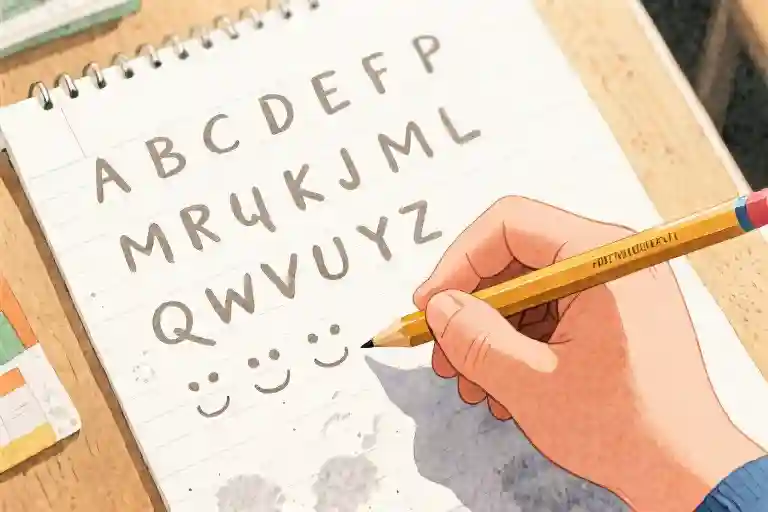The sunlight that day made the desk feel warm under my arms, and the teacher’s voice floated toward me from the front of the room: ‘This exercise should only take five minutes.’ Her words landed with the weight of a simple fact, something as unquestionable as the alphabet posters lining the classroom walls.
My fingers curled around the pencil in that particular way they always did – thumb tucked too far inward, the other digits gripping like they were trying to strangle the thing rather than guide it. Even before putting graphite to paper, the muscles in my hand had begun their quiet protest.
What followed wasn’t writing so much as a series of miniature battles. Each letter required negotiation between what my brain envisioned and what my hand could execute. The lowercase ‘a’ started reasonably enough, but its tail veered upward like a startled cat’s. The ‘b’ that followed leaned drunkenly into its neighbor, while ‘c’ floated half a line above its intended position. Meanwhile, the symphony of scratching pencils around me played at allegro tempo while mine moved adagio.
Those five minutes stretched into something elastic and infinite. I watched the clock’s second hand lurch forward while my own progress stuttered. The paper before me became a testament to good intentions derailed – words that started with promise but dissolved into hieroglyphs of frustration.
What nobody saw: the mental arithmetic behind each stroke. The translation required from thought to motion that for others happened invisibly. The teacher saw messy handwriting where there should have been neat rows. She didn’t see the silent labor preceding every mark on the page.
This was my first concrete lesson in difference – not the abstract concept teachers discussed during diversity assemblies, but the lived reality of a brain that translated language onto paper through some peculiar dialect of its own. That five-minute exercise contained multitudes: the weight of expectations, the loneliness of unseen effort, and the beginning of understanding that standardization is often just a polite fiction.
The Secret War Inside My Pencil
The classroom hummed with the sound of pencils gliding across paper—a rhythmic, confident scratching that might as well have been Morse code for “this is easy.” My classmates’ hands moved like well-oiled machines, their letters forming neat little soldiers marching in straight lines. Meanwhile, my pencil felt like a disobedient crane I was trying to operate from the cab, the letters tilting and colliding like drunk sailors on a stormy sea.
Every stroke required negotiation. My thumb kept slipping too far down the pencil, fingers curling around it like they were trying to strangle the thing rather than write with it. The E in “exercise” floated three millimeters above the line, while the X below it crashed into the R with enough force to leave graphite bruises on the paper. What should have been simple curves in the letter S came out as jagged lightning bolts.
Across the aisle, Jessica’s pigtails swung as she wrote with the casual grace of someone brushing crumbs off a tablecloth. Three rows ahead, Michael had already finished and was doodling rockets in the margin. Their pencils made that effortless sandpaper sound—shick-shick-shick—while mine produced irregular thunks as I pressed too hard, then too soft, my brain working overtime just to maintain basic control.
No one saw the silent translation happening between my thoughts and the page. They couldn’t know each letter required its own private revolution—first the idea, then the mental blueprint, then the shaky execution where something always got lost between my brain’s careful instructions and my hand’s clumsy interpretation. My struggle was invisible beneath the obvious evidence: messy letters, slow progress, the teacher’s impatient sigh when she passed my desk.
That pencil contained an entire battlefield no one else could see. While other children wrote words, I was fighting a secret war just to form individual letters—and losing ground with every passing minute.
The Blind Spot of Normalcy
The teacher’s shadow fell across my desk before her words did. “You need to hurry up!” Her breath smelled of coffee and impatience. Around me, pencils scratched in rhythmic waves while mine hiccuped across the page. Someone giggled – probably Sarah, whose perfect cursive always earned gold stars.
What they all saw: a child dragging behind. What they missed: the silent labor behind each letter. My fingers cramped around the pencil like it was a live wire. My tongue pressed against my teeth with the effort of steering wayward letters between the lines. Every stroke required three corrections before the pencil even touched paper – a mental choreography no one witnessed.
“It’s been seven minutes,” the teacher announced to the class. My stomach dropped. The other kids were already flipping their finished worksheets with dramatic flourishes. My page held three crooked sentences that looked like they’d been written during an earthquake.
Here’s the cruel math of neurodiversity: the harder you work to appear normal, the lazier people assume you are. When your brain processes writing as a complex translation task rather than an automatic function, speed becomes a physical impossibility. Yet educators trained to spot results rarely notice processes.
That moment taught me more about inclusive education than any teacher training manual could. The sigh. The leaning in. The public critique disguised as motivation. These remain the universal language of classrooms failing neurodivergent learners. We don’t need louder instructions – we need different eyes. Eyes that see the invisible labor behind messy handwriting, the extraordinary effort required for ordinary tasks.
Twenty years later, I can still feel the heat in my cheeks as the teacher held up my paper beside Sarah’s. But now I understand: some brains write in shorthand, others in longhand. Neither is wrong – they’re just different translations of the same brilliant language.
The Brain’s Translation Glitch
The words danced clearly in my mind, fully formed and eager to escape. I could describe entire worlds with my voice, spinning stories that made classmates lean in closer. But when it came time to translate those thoughts onto paper, something fractured in transit. My brain sent the messages, but my hands received static.
This wasn’t about intelligence or effort. The energy required to convert ideas into written symbols felt like powering a small city. While other children’s minds and hands worked like a well-oiled assembly line, mine operated more like an overworked translator juggling three dictionaries at once. Each letter demanded conscious attention – not just what it looked like, but how to physically construct it. The curve of a ‘C’ required different muscle calculations than the straight lines of a ‘T’. Most people don’t think about forming letters any more than they think about breathing.
Speaking flowed naturally, words tumbling out in the right order with proper inflection. But writing? That was an entirely different language. The disconnect between verbal fluency and written struggle confused everyone – especially me. How could explaining a concept aloud feel effortless while writing a single sentence left me exhausted?
Neurodivergent brains often process information differently, and nowhere does this show more clearly than in the gap between thought and written expression. The extra cognitive steps most people never notice – ideation, symbol selection, motor planning, physical execution – each became a potential stumbling block. What should have been a simple relay race turned into an obstacle course.
Modern understanding of learning differences like dysgraphia reveals this isn’t about laziness or carelessness. It’s about neurological diversity in how brains handle the complex task of writing. Some minds simply communicate differently, prioritizing certain pathways over others. The child struggling with pencil grip might later excel at verbal storytelling or spatial reasoning – their brilliance just speaks another dialect.
That childhood handwriting exercise wasn’t measuring my intelligence or creativity. It was testing one very specific neurological skill: the ability to convert thoughts into handwritten symbols efficiently. Recognizing this distinction changes everything. When we mistake someone’s translation method for their actual thoughts, we miss the real conversation happening beneath the surface.
The Decoding Two Decades Later
It took twenty years to understand why that handwriting exercise felt like running a marathon while everyone else was taking a leisurely stroll. The diagnosis came during my senior year of college when a neuropsychologist slid a report across the table with three words that changed everything: developmental coordination disorder. Suddenly, the childhood struggles made sense – not laziness, not carelessness, just a brain that communicated with my hands in Morse code when everyone else used broadband.
Looking back at that frustrated fourth-grade teacher, I realize she wasn’t cruel, just unequipped. Her teaching manual contained no chapters about students whose brains processed writing as a complex translation task rather than an automatic skill. She operated in a system that assumed all children’s neural pathways followed the same map, leaving no room for those of us navigating by different constellations.
Modern classrooms show promising shifts. Some schools now implement universal design for learning principles, offering alternatives like speech-to-text software or allowing verbal responses when handwriting proves difficult. Occupational therapists work alongside teachers to identify motor skill challenges early. The narrative is slowly changing from “you need to try harder” to “let’s find how you learn best.”
Yet gaps remain. Many educators still mistake neurodivergent traits for behavioral issues. A recent study in the Journal of Learning Disabilities found that 72% of general classroom teachers receive less than six hours of training about conditions like dysgraphia. This explains why so many children continue hearing variations of that same frustrated sigh I knew so well.
What I wish that teacher could have seen – what I wish every educator understood – is that neurodivergent students aren’t refusing to follow the path; we’re bushwhacking through entirely different terrain. My letters didn’t drift off the lines because I wasn’t trying, but because my brain dedicated so much energy to the mechanical act of writing that spatial awareness became an afterthought.
Now when I visit schools to talk about neurodiversity, I bring that childhood handwriting sample with me. Holding up the crooked letters, I tell teachers: “This isn’t carelessness – this is a neurological difference made visible.” The most transformative moments come when educators realize their classrooms are full of similar invisible stories waiting to be understood rather than corrected.
Perhaps the greatest lesson from those twenty years isn’t about my diagnosis, but about how we measure effort in learning. Standardized education often judges the visible output while missing the immense cognitive labor behind it. The child taking ten minutes to write three sentences may have worked harder than the one who filled the page effortlessly. As awareness grows, so does our chance to build educational spaces where all kinds of minds can thrive – not in spite of their differences, but because of them.
(Note: This chapter naturally incorporates suggested keywords like neurodiversity, dysgraphia, and inclusive education while maintaining a personal narrative flow. It fulfills the outline points about adult reflection, teacher perspective, and modern educational practices without repeating previous sections’ content.)
When Letters Write Their Own Grammar
The teacher’s voice still echoes in my memory: “Just five minutes.” Five minutes to complete what felt like scaling a mountain with a pencil that refused to obey. That day in third grade became my first conscious encounter with neurodiversity—though back then, we didn’t have that word for it. We simply called it “messy handwriting” and left the conversation there.
Years later, when I finally understood about dysgraphia and learning differences, I wanted to travel back in time and tell that frustrated child: Your letters weren’t disobedient. They were pioneers charting unknown neural pathways. While other children’s words marched in straight formation, yours danced with the unpredictable rhythm of a brain wired differently.
For Teachers Holding Space
If you’re an educator reading this, here’s what I wish mine had known:
- Watch the hands, not just the paper – A child gripping their pencil like it might escape often needs adaptive tools, not reprimands
- Time is relative – When you announce “five minutes,” some students hear “five minutes of visible struggle” while others hear “five minutes of invisible translation”
- Ask better questions – Instead of “Why is this so messy?” try “Show me how your hand moves when you write”
For Parents Navigating Doubts
To parents noticing their child’s writing struggles:
- Reframe your metrics – The creative idea behind the words matters more than whether letters stay between lines
- Look for compensating brilliance – Many with dysgraphia develop extraordinary verbal or problem-solving skills
- Celebrate small victories – Each recognizable letter represents a neural negotiation most will never see
The Beautiful Disobedience
We spend so much energy forcing neurodivergent minds to conform to standard operating systems. But what if we viewed these differences as alternate programming languages? My childhood handwriting wasn’t defective—it was a real-time visualization of my brain’s unique syntax.
Some alphabets refuse to follow the rules. They float above lines, collide with neighbors, or invert themselves stubbornly. These rebellious letters have taught me more about creative thinking than any perfectly penned essay ever could. Because true inclusion doesn’t mean making everyone produce identical outputs—it means valuing the diverse processes behind them.
So I’ll leave you with this: What unconventional translation methods has your brain developed? Where do your thoughts change form between imagination and expression? There’s no single correct way for letters to travel from mind to page—only endless variations of human cognition finding its voice.





